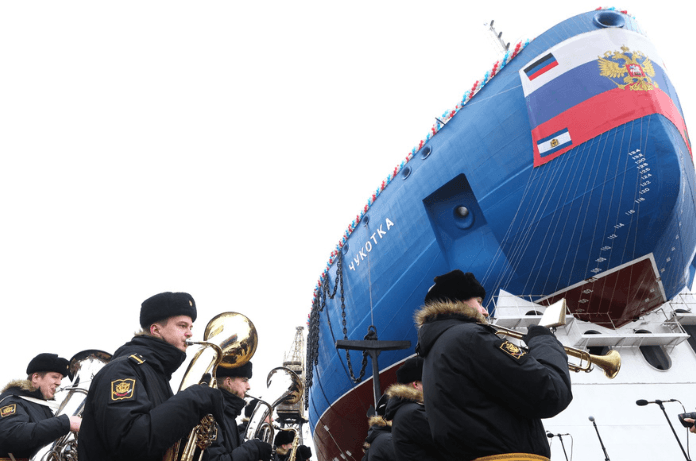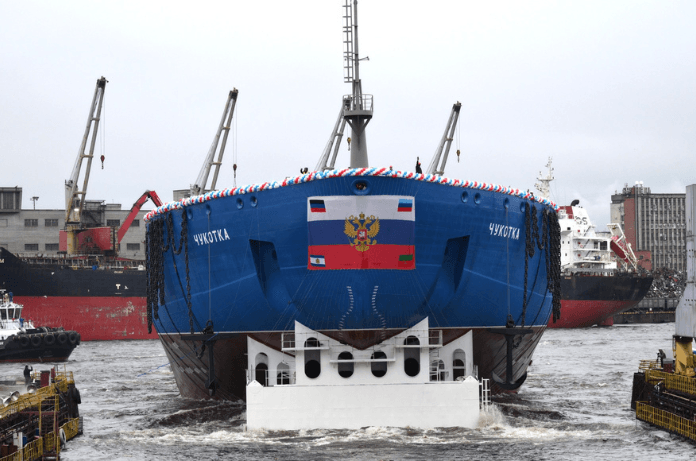A new era in Arctic exploration has begun with the launch of the Chukotka nuclear-powered icebreaker at the Baltic Shipyard in St. Petersburg. As the fifth vessel in the Project 22220 series, these nuclear icebreakers are the world’s largest and most powerful vessels designed to ensure year-round navigation in the Arctic. With its advanced nuclear technology, the Chukotka is a game-changer for Russia’s strategy to control the Northern Sea Route (NSR) and solidify its place as a leader in Arctic shipping.
The Chukotka Icebreaker and Russia’s Arctic Strategy
The Latest Icebreaker in the Project 22220 Series
The Chukotka joins the series of Russia’s growing fleet of nuclear-powered icebreakers, following the services of the Arktika, Sibir, Ural, and Yakutia. The Sixth in the series Leningrad, is currently under construction at the Baltic Shipyard. Then comes the seventh in the series Stalingrad icebreaker is on order. Russia is rapidly expanding its capabilities to control and navigate through the Northern Sea Route, a critical artery for global trade.

Powered by Advanced Nuclear Technology
Equipped power plant, which is the heart of the ship, has two RITM-200 nuclear reactors, each delivering 55 megawatts of power, the Chukotka is built to break through the thickest Arctic ice with ease. These cutting-edge reactors were designed by Russia’s reactor engineers, including the OKBM Afrikantov design bureau, in Nizhny Novgorod. These reactors are widely used to ensure that the icebreaker can operate in the harshest conditions, providing a reliable and sustainable energy source for Arctic navigation.
Strengthening Arctic Infrastructure
In addition to these powerful icebreakers, Russia is investing heavily in developing the necessary infrastructure to support its growing presence in the Arctic. This includes expanding port facilities, improving rail access to Arctic hubs, and enhancing satellite navigation and communication systems. These efforts are all part of Russia’s strategy to transform the Northern Sea Route into a vital, year-round trade corridor, reducing shipping times between Europe and Asia.
Technological Independence and Local Production
Russia is committed to achieving technological self-sufficiency, particularly when it comes to the production of critical shipboard equipment. Over 47 domestic enterprises are currently working on developing 89 new types of equipment for these icebreakers. By increasing the localization of manufacturing and technology, Russia is positioning itself to lead the global shipbuilding industry and reduce reliance on foreign suppliers.
Expanding Global Trade and Arctic Research
The Chukotka and its sister ships will not only enhance Russia’s ability to manage Arctic shipping but also open the door for international trade. As interest in the Northern Sea Route continues to rise, these icebreakers will facilitate the safe and efficient transport of goods, while also supporting important scientific research into Arctic ecosystems, climate change, and natural resource extraction. The Arctic is becoming increasingly important, and Russia’s expanding icebreaker fleet is a central part of this shift.
What Putin and Alexei Likhachev Had to Say
During the launch event on November 6, 2024, in St Petersburg, both President Vladimir Putin and Rosatom Director General Alexei Likhachev addressed the importance of these advanced icebreakers and Russia’s broader Arctic strategy.
Vladimir Putin emphasized Russia’s commitment to developing the Northern Sea Route as a key shipping artery for global trade. He stated, “Our plans to develop our Arctic territories and to increase cargo traffic along the Northern Sea Route rely on expanding Russia’s icebreaker fleet.” He also underscored the importance of improving shipping safety and reliability in the Arctic region, citing the need for better satellite navigation, ice monitoring, and port infrastructure.
Alexei Likhachev highlighted the technological advancements behind the Chukotka icebreaker, particularly the RITM-200 reactors. He said, “The new icebreaker’s onboard power plant, which is the heart of the ship, has two RITM-200 reactors, each with a capacity of 55 megawatts. Designed by our reactor engineers, these reactors are widely used on icebreakers and will continue to play a crucial role in the development of the Northern Sea Route.” He also discussed Rosatom’s strategy for both Arctic and tropical regions, mentioning that “new contracts to build them were secured during the BRICS summit.”
Paving the Way for a New Arctic Era
The launch of the Chukotka nuclear-powered icebreaker marks a significant milestone in Russia’s Arctic strategy, showcasing the country’s commitment to becoming a dominant force in Arctic navigation and global trade. With its nuclear-powered fleet, state-of-the-art technology, and massive investment in infrastructure, Russia is prepared to unlock the full potential of the Northern Sea Route and strengthen its leadership in the Arctic region. As traffic along this vital route increases, Russia’s icebreakers will be crucial to ensuring safe and efficient passage through one of the world’s most challenging environments.
Ready to see the Arctic open for business? Keep an eye on Russia’s growing fleet of icebreakers and the opportunities the Northern Sea Route will unlock for global trade. The future of Arctic navigation is here, and it’s powered by cutting-edge technology

